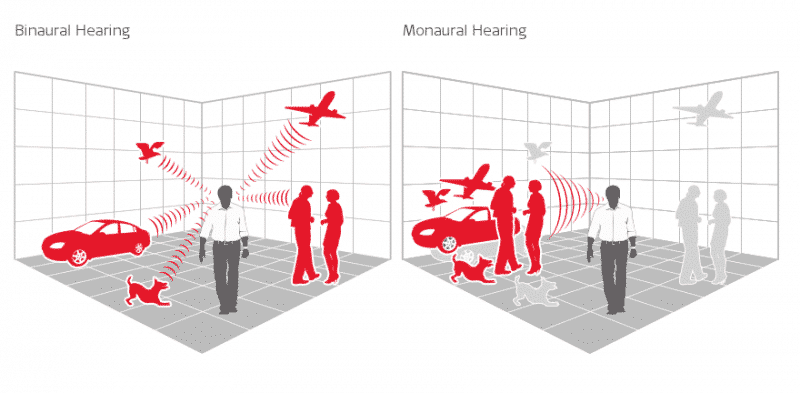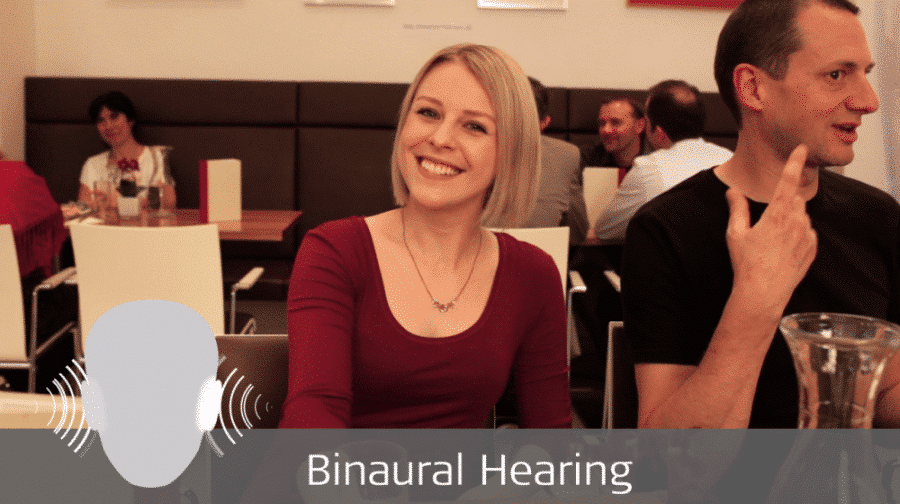
MED-EL
Published Aug 02, 2017 | Updated Nov 3, 2025
Binaural Hearing: Cochlear Implants & Single-Sided Deafness
In this article, we’ll explore why binaural hearing is so important, highlight its key benefits, and look at potential solutions for those with hearing loss in one ear. It’s a slightly longer read than usual but well worth it. To help you experience the benefits of binaural hearing firsthand, we’ve included a powerful video featuring immersive 3D audio.

Key Takeaways
- Binaural hearing—the ability to hear with both ears—plays a crucial role in our ability to understand speech in noisy environments, locate sounds, and interact with our surroundings.
- Cochlear implants are the ideal first-choice treatment option for many people with single-sided deafness (SSD), offering benefits beyond what other solutions provide.
- MED-EL cochlear implants were first to receive US FDA and TÜV approval for treating single-sided deafness and asymmetric hearing loss in the United States and Europe.
- Unlike other cochlear implants, only MED-EL cochlear implants offer sound quality that is closest to natural hearing.
Binaural hearing—the ability to hear with both ears—plays a crucial role in how we perceive and interact with our surroundings. It allows us to pinpoint where sounds are coming from, follow conversations in noisy environments, and feel more spatially aware and connected. That’s why losing hearing on one side—known as unilateral hearing loss (UHL) or single-sided deafness (SSD)—can have a greater impact on quality of life than many people expect.
How Does Losing Binaural Hearing Impact Everyday Life?
Often, individuals with single-sided deafness have nearly normal speech understanding in quiet. This can give friends & family the impression that single-sided deafness is only a minor issue. However, unilateral hearing loss ear has a significant impact on quality of life and should be recognized as a serious burden on individuals.
In everyday noisy settings, speech can be very difficult to understand with only one hearing ear. Sounds from the side with hearing loss are significantly muffled by the “head shadow” effect. Unilateral hearing loss also makes it very challenging, if not impossible, to tell where sounds are coming from.Dillon MT; Kocharyan A; Daher GS; Carlson ML; Shapiro WH; Snapp HA; Firszt JB (2022). American Cochlear Implant Alliance Task Force Guidelines for Clinical Assessment and Management of Adult Cochlear Implantation for Single-Sided Deafness. Ear Hear. 43(6), p. 1605–1619.[1]Daher GS; Kocharyan A; Dillon MT; Carlson ML (2023). Cochlear Implantation Outcomes in Adults With Single-Sided Deafness: A Systematic Review and Meta-analysis. Otol. Neurotol. 44(4), p. 297–309.[2]Oh SJ; Mavrommatis MA; Fan CJ; DiRisio AC; Villavisanis DF; Berson ER et al. (2023). Cochlear Implantation in Adults With Single-Sided Deafness: A Systematic Review and Meta-analysis. Otolaryngol Head Neck Surg, 168(2), p. 131-42[3]
People with single-sided deafness often experience:
- Diminished speech understanding in noiseDillon MT; Kocharyan A; Daher GS; Carlson ML; Shapiro WH; Snapp HA; Firszt JB (2022). American Cochlear Implant Alliance Task Force Guidelines for Clinical Assessment and Management of Adult Cochlear Implantation for Single-Sided Deafness. Ear Hear. 43(6), p. 1605–1619.[1]
- Extra listening effort that can be exhaustingSu, W., Xia, Y., Xia, C., Zhang, Y., Zhang, Y., & Liu, Y. (2025). Impact of Single‐Side Deafness on Listening Effort: A Prospective Comparative Study. Laryngoscope Investigative Otolaryngology, 10(4), e70185. https://doi.org/10.1002/lio2.70185[4]
- Increased anxiety in busy or noisy places
Lucas, L., Katiri, R., & Kitterick, P. T. (2017). The psychological and social consequences of single-sided deafness in adulthood. International Journal of Audiology, 57(1), 21–30. https://doi.org/10.1080/14992027.2017.1398420
[5] - Inability to tell where sounds are coming fromDaher GS; Kocharyan A; Dillon MT; Carlson ML (2023). Cochlear Implantation Outcomes in Adults With Single-Sided Deafness: A Systematic Review and Meta-analysis. Otol. Neurotol. 44(4), p. 297–309.[2]
- Difficulties at work and social gatheringsHarkonen K; Kivekas I; Rautiainen M; Kotti V; Sivonen V; Vasama JP (2015). Single-Sided Deafness: The Effect of Cochlear Implantation on Quality of Life, Quality of Hearing, and Working Performance. ORL J Otorhinolaryngol Relat Spec, 77(6), p. 339-45[6]
Imagine struggling to follow conversations at work or always having to turn your head so your healthy ear can understand a friend. Even worse is the constant worry that you won’t notice sudden noises from a car or biker when crossing the street. Even with “one good ear”, everyday life with single-sided deafness can be exhausting.
“Hearing with only one ear is like living in a black and white world, without knowing that somewhere else colors exist.”
Johanna, MED-EL cochlear implant recipient with single-sided deafness
What Are the Treatment Options for SSD? Which Solutions Restore Binaural Hearing?
Treatment options for SSD include monaural solutions like CROS hearing aids and bone conduction implants, which improve sound awareness but do not restore binaural hearing. Cochlear implants offer a more effective approach by reactivating the deafened ear, significantly improving speech understanding, reducing listening effort, and helping to restore sound localization. A cochlear implant is the only solution for SSD to restore binaural hearing.Thompson NJ; Dillon MT; Buss E; Rooth MA; Richter ME; Pillsbury HC; Brown KD (2022). Long-Term Improvement in Localization for Cochlear Implant Users with Single-Sided Deafness. Laryngoscope 132(12), p. 2453–2458.[7]
MED-EL: The World Leader & Pioneers in SSD Treatment
- In 2013, MED-EL was the first CI manufacturer in the world to receive the CE mark for SSD, highlighting its leadership in expanding the candidacy for cochlear implants in Europe.
Dhanasingh, A., & Hochmair, I. (2021). CI in single-sided deafness. Acta Oto-Laryngologica, 141(sup1), 82–105. https://doi.org/10.1080/00016489.2021.1888496
[10] - In 2019, MED-EL cochlear implants were the first to receive FDA approval for treating single-sided deafness (SSD) and asymmetric hearing loss in the United States.US Food & Drug Administration. (2019). Premarket approval, MED-EL Cochlear Implant System. PMA P000025/S104: SUMMARY OF SAFETY AND EFFECTIVENESS DATA (SSED). https://www.accessdata.fda.gov/scripts/cdrh/cfdocs/cfpma/pma.cfm?id=P000025S104[8]Hearing Health Matters. (2019). FDA approves MED-EL cochlear implant systems for Single-Sided deafness and asymmetric hearing loss. Hearing Health & Technology Matters. https://hearinghealthmatters.org/hearing-technologies/2019/cochlear-implant-single-sided-deafness-fda-approval-med-el/[9]
Reaching these milestones has helped pave the way for the entire hearing technology industry to move forward worldwide, with MED-EL continuing to lead and drive innovation.
Monaural Treatment Options for Unilateral Hearing Loss
Monaural solutions for single-sided deafness (SSD) work by redirecting sounds from the deaf side to the hearing ear. Essentially, sounds from both sides are combined and presented to the functioning ear, improving overall sound awareness.
CROS hearing aids send sounds from a microphone on the deafened side to a hearing aid in the hearing ear. Bone conduction implants use an implant & audio processor on the deafened side to send sounds through the head to the functional cochlea on the hearing side.
These systems are able to reduce the head shadow effect by providing sounds from both sides of the head. This can provide improved speech understanding and substantially improve awareness of sounds from all sides.
However, these monaural treatment methods can have several disadvantages. Sound localization is generally not improved, because the ability to hear where a sound is coming from relies on binaural input from both ears—including both cochleae.Heteren JAA van; Oorschot HD van; Wendrich AW; Peters JPM; Rhebergen KS; Grolman W; Stokroos RJ; Smit AL (2024). Sound Localization in Single-Sided Deafness; Outcomes of a Randomized Controlled Trial on the Comparison Between Cochlear Implantation, Bone Conduction Devices, and Contralateral Routing of Signals Hearing Aids. Trends Hear. 28, p. 23312165241287092.[11]Agterberg MJH; Snik AFM; Goor RMGV de; Hol MKS; Opstal AJV (2019). Sound-localization performance of patients with single-sided deafness is not improved when listening with a bone-conduction device. Hear. Res. 372, p. 62–68.[12] Furthermore, background noise picked up from the microphone on the deafened side and routed to the hearing ear can reduce speech understanding if noise is presented on the deafened side.Wesarg T; Kuntz I; Jung L; Wiebe K; Schatzer R; Brill S; Aschendorff A; Arndt S (2024). Masked Speech Perception with Bone Conduction Device, Contralateral Routing of Signals Hearing Aid, and Cochlear Implant Use in Adults with Single-Sided Deafness: A Prospective Hearing Device Comparison using a Unified Testing Framework. Audiol. Neurotol. p. 1–19.[13]Heteren JAA van; Wendrich AW; Peters JPM; Grolman W; Stokroos RJ; Smit AL (2025). Speech Perception in Noise After Cochlear Implantation for Single-Sided Deafness. JAMA Otolaryngol.Head Neck Surg. 151(3).[14]Park LR; Dillon MT; Buss E; O’Connell BP; Brown KD (2021). Spatial Release From Masking in Pediatric Cochlear Implant Recipients With Single-Sided Deafness. Am. J. Audiol. p. 1–9.[15]
Why Are Cochlear Implants the Ideal Treatment Option for SSD?
Cochlear implants are considered an ideal treatment for single-sided deafness because, unlike monaural solutions, they can help restore true binaural hearing—hearing with both ears.
By bypassing the damaged hair cells in the affected cochlea, a cochlear implant reactivates the deafened ear, enabling the brain to receive input from both sides. This bilateral stimulation allows individuals with SSD to experience significant improvements in speech understanding, reduced listening effort, and enhanced sound localization.Thompson NJ; Dillon MT; Buss E; Rooth MA; Richter ME; Pillsbury HC; Brown KD (2022). Long-Term Improvement in Localization for Cochlear Implant Users with Single-Sided Deafness. Laryngoscope 132(12), p. 2453–2458.[7]Thompson NJ; Brown KD; Buss E; Rooth MA; Richter ME; Dillon MT (2023). Long-Term Binaural Hearing Improvements for Cochlear Implant Users with Asymmetric Hearing Loss. Laryngoscope 133(6), p. 1480–1485.[16]Thompson NJ; Lopez EM; Dillon MT; Rooth MA; Richter ME; Pillsbury HC; Brown KD (2023). Cochlear Implantation for Unilateral and Asymmetric Hearing Loss: Long-Term Subjective Benefit. Laryngoscope 133(10), p. 2792–2797.[17]Tavora-Vieira D; Rajan GP; Heyning PV de; Mertens G (2019). Evaluating the Long-Term Hearing Outcomes of Cochlear Implant Users With Single-Sided Deafness. Otol. Neurotol. 40(6), p. e575–e580.[18]Park LR; Dillon MT; Buss E; Brown KD (2023). Two-Year Outcomes of Cochlear Implant Use for Children With Unilateral Hearing Loss: Benefits and Comparison to Children With Normal Hearing. Ear Hear. 44(5), p. 955–68.[19]Hicks KB; Park LR; Brown KD; Dillon MT (2024). Long-Term Perceived Benefit of Pediatric Cochlear Implant Users with Unilateral Hearing Loss. Laryngoscope 134(2), p. 919–925.[20]Cuda, D., Pizzol, E., Laborai, A., Salsi, D., & Ghiselli, S. (2025). Cochlear implant benefits over time in adult patients with Single Sided Deafness. European Archives of Oto-Rhino-Laryngology, 282(10), 5023-5035. https://doi.org/10.1007/s00405-025-09298-9[34] In everyday life, these benefits translate to clearer conversations, better awareness of surroundings, and less fatigue in noisy environments.Wesarg T; Kuntz I; Jung L; Wiebe K; Schatzer R; Brill S; Aschendorff A; Arndt S (2024). Masked Speech Perception with Bone Conduction Device, Contralateral Routing of Signals Hearing Aid, and Cochlear Implant Use in Adults with Single-Sided Deafness: A Prospective Hearing Device Comparison using a Unified Testing Framework. Audiol. Neurotol. p. 1–19.[13]Park LR; Dillon MT; Buss E; O’Connell BP; Brown KD (2021). Spatial Release From Masking in Pediatric Cochlear Implant Recipients With Single-Sided Deafness. Am. J. Audiol. p. 1–9.[15]Lorens A; Kruszynska M; Obrycka A; Skarzynski PH; Wilson B; Skarzynski H (2019). Binaural advantages in using a cochlear implant for adults with profound unilateral hearing loss. Acta Oto-Laryngol. 139(2), p. 153–161.[21]

Let’s look at how a cochlear implant for single-sided deafness offers improved speech understanding in both quiet and noise.
In noisy environments, the advantages of a cochlear implant for single-sided deafness are especially prominent. With two hearing cochleae, you can experience spatial hearing—hearing in 3D—which helps the brain separate the sounds in a 3D space and selectively process the information. With spatial hearing, there are three main mechanisms for improving speech understanding in noise: binaural summation, the squelch effect, and the head shadow effect.
- Binaural summation: Hearing with both ears provides a louder and more robust sound signal for the brain. This offers a 1–2 dB SNR improvement in noise for both normal-hearing and bilateral cochlear implant listeners, and can reduce listening effort in general.Wesarg T; Kuntz I; Jung L; Wiebe K; Schatzer R; Brill S; Aschendorff A; Arndt S (2024). Masked Speech Perception with Bone Conduction Device, Contralateral Routing of Signals Hearing Aid, and Cochlear Implant Use in Adults with Single-Sided Deafness: A Prospective Hearing Device Comparison using a Unified Testing Framework. Audiol. Neurotol. p. 1–19.[13]Park LR; Dillon MT; Buss E; O’Connell BP; Brown KD (2021). Spatial Release From Masking in Pediatric Cochlear Implant Recipients With Single-Sided Deafness. Am. J. Audiol. p. 1–9.[15]
- Squelch effect: By comparing sounds received in both ears, central auditory processing in the brain can improve the quality of a sound and filter out noise. This primarily uses redundant information of the sound as received by the two ears. Even an ear hearing mostly noise will still provide an SNR benefit of ~3 dB in normal-hearing listeners, as binaural listening provides a more complete sound signal for auditory processing.Wesarg T; Kuntz I; Jung L; Wiebe K; Schatzer R; Brill S; Aschendorff A; Arndt S (2024). Masked Speech Perception with Bone Conduction Device, Contralateral Routing of Signals Hearing Aid, and Cochlear Implant Use in Adults with Single-Sided Deafness: A Prospective Hearing Device Comparison using a Unified Testing Framework. Audiol. Neurotol. p. 1–19.[13]Lorens A; Kruszynska M; Obrycka A; Skarzynski PH; Wilson B; Skarzynski H (2019). Binaural advantages in using a cochlear implant for adults with profound unilateral hearing loss. Acta Oto-Laryngol. 139(2), p. 153–161.[21]
- Head shadow effect: The head is a natural barrier between the ears that muffles higher frequencies (1000 Hz and up) by as much as 20 dB when sounds arriving from the opposite side travel around the head to reach the ear. Without an implant or CROS system, sounds on the deafened side are very difficult to hear.Wesarg T; Kuntz I; Jung L; Wiebe K; Schatzer R; Brill S; Aschendorff A; Arndt S (2024). Masked Speech Perception with Bone Conduction Device, Contralateral Routing of Signals Hearing Aid, and Cochlear Implant Use in Adults with Single-Sided Deafness: A Prospective Hearing Device Comparison using a Unified Testing Framework. Audiol. Neurotol. p. 1–19.[13]Park LR; Dillon MT; Buss E; O’Connell BP; Brown KD (2021). Spatial Release From Masking in Pediatric Cochlear Implant Recipients With Single-Sided Deafness. Am. J. Audiol. p. 1–9.[15]
A CROS or bone conduction system can help to restore sound awareness to both sides, but in settings with background noise, these systems may not always be as advantageous as expected. If noise is presented to the CROS or bone conduction device and speech to the naturally hearing ear, the CROS or bone conduction system would add the noise to the hearing cochlea, creating a significant reduction in speech understanding.Wesarg T; Kuntz I; Jung L; Wiebe K; Schatzer R; Brill S; Aschendorff A; Arndt S (2024). Masked Speech Perception with Bone Conduction Device, Contralateral Routing of Signals Hearing Aid, and Cochlear Implant Use in Adults with Single-Sided Deafness: A Prospective Hearing Device Comparison using a Unified Testing Framework. Audiol. Neurotol. p. 1–19.[13]Heteren JAA van; Wendrich AW; Peters JPM; Grolman W; Stokroos RJ; Smit AL (2025). Speech Perception in Noise After Cochlear Implantation for Single-Sided Deafness. JAMA Otolaryngol.Head Neck Surg. 151(3).[14]Park LR; Dillon MT; Buss E; O’Connell BP; Brown KD (2021). Spatial Release From Masking in Pediatric Cochlear Implant Recipients With Single-Sided Deafness. Am. J. Audiol. p. 1–9.[15]
In contrast, a cochlear implant provides significant benefit in any noise configuration, without the speech understanding reduction seen with CROS. Using two physically separate cochleae allows noise presented on either side of the head to be filtered out using central auditory processing of the brain.
Therefore, a cochlear implant offers significantly better speech understanding in noise than monaural hearing with a CROS or bone conduction system, especially when noise is presented on the implanted side.Wesarg T; Kuntz I; Jung L; Wiebe K; Schatzer R; Brill S; Aschendorff A; Arndt S (2024). Masked Speech Perception with Bone Conduction Device, Contralateral Routing of Signals Hearing Aid, and Cochlear Implant Use in Adults with Single-Sided Deafness: A Prospective Hearing Device Comparison using a Unified Testing Framework. Audiol. Neurotol. p. 1–19.[13]Heteren JAA van; Wendrich AW; Peters JPM; Grolman W; Stokroos RJ; Smit AL (2025). Speech Perception in Noise After Cochlear Implantation for Single-Sided Deafness. JAMA Otolaryngol.Head Neck Surg. 151(3).[14]Park LR; Dillon MT; Buss E; O’Connell BP; Brown KD (2021). Spatial Release From Masking in Pediatric Cochlear Implant Recipients With Single-Sided Deafness. Am. J. Audiol. p. 1–9.[15]
What’s the practical benefit of binaural hearing? Check out this simulation we created using 3D binaural microphones to compare single-sided deafness and binaural listening.
More Single-Sided Deafness & Unilateral Hearing Loss Simulations
Meet Your Friends, simulates a group conversation in a noisy restaurant. After listening, viewers are asked to locate the source of a sound or answer questions to test their ability to understand a conversation in a noisy setting with unilateral hearing loss.
It is a part of Switch on Life, a platform that provides brief immersive experiences that simulate everyday life with different types of hearing loss.
Hearing professionals can use Switch on Life to demonstrate the effects of unilateral hearing loss to family members or caretakers of patients with SSD or others who want to learn more.
Closest to Natural Hearing: MED-EL’s Unique Approach to SSD
The auditory benefits of binaural hearing with a MED-EL cochlear implant are significantly better than hearing with a CROS or bone conduction system. Therefore, a cochlear implant should generally be the considered the first-choice treatment option for single-sided deafness.Dillon MT; Kocharyan A; Daher GS; Carlson ML; Shapiro WH; Snapp HA; Firszt JB (2022). American Cochlear Implant Alliance Task Force Guidelines for Clinical Assessment and Management of Adult Cochlear Implantation for Single-Sided Deafness. Ear Hear. 43(6), p. 1605–1619.[1]Park LR; Griffin AM; Sladen DP; Neumann S; Young NM (2022). American Cochlear Implant Alliance Task Force Guidelines for Clinical Assessment and Management of Cochlear Implantation in Children With Single-Sided Deafness. Ear Hear. 43(2), p. 255–267.[22]
However, it’s also important to remember that a person with single-sided deafness still has natural hearing in one ear. This makes sound quality an especially important consideration, as a mismatch in sound quality may distort the binaural auditory processing of those sounds in the brain.Park LR; Dillon MT; Buss E; O’Connell BP; Brown KD (2021). Spatial Release From Masking in Pediatric Cochlear Implant Recipients With Single-Sided Deafness. Am. J. Audiol. p. 1–9.[15]Bernstein JGW; Jensen KK; Stakhovskaya OA; Noble JH; Hoa M; Kim HJ; Shih R; Kolberg E; Cleary M; Goupell MJ (2021). Interaural Place-of-Stimulation Mismatch Estimates Using CT Scans and Binaural Perception, But Not Pitch, Are Consistent in Cochlear-Implant Users. J. Neurosci. 41(49), p. 10161–10178.[23]Gersdorff G; Ivanovic N; Assadi MZ; Nopp P; Camby S; Lefèbvre P (2025). The importance of frequency–place mismatch in the quality of sound perceived in single-sided deafness among cochlear implant recipients. Front. Audiol. Otol. 3, p. 1648716.[26]
Unlike any other cochlear implant, only a MED-EL cochlear implant can offer sound quality that is the closest to natural hearing.Dorman MF; Natale SC; Noble JH; Zeitler DM (2022). Upward Shifts in the Internal Representation of Frequency Can Persist Over a 3-Year Period for Cochlear Implant Patients Fit With a Relatively Short Electrode Array. Front. Hum. Neurosci. 16, p. 863891.[24]Rader, T., Döge, J., Adel, Y., Weissgerber, T., & Baumann, U. (2016). Place dependent stimulation rates improve pitch perception in cochlear implantees with single-sided deafness. Hear Res., 339, 94–103.[25] This is only possible through the proven combination of atraumatic electrode insertion with proven hearing preservation, stimulation of the whole cochlea with electrode arrays individualized to fit each ear, and pitch-matched sound coding.Büchner, A., Weller, T., Penninger, R., Helpard, L., Ladak, H. M., Agrawal, S., ... & Schurzig, D. The Greenwood Function shows close alignment with Pitch Perceived by Cochlear Implant Patients with Long, Flexible Electrode Arrays and Fine-Structure Stimulation. Frontiers in Neuroscience, 19, 1624499. https://doi.org/10.3389/fnins.2025.1624499[33]Lee, S. E., Brown, K. D., Overton, A. B., Thompson, N. J., Sloop, A. D., Richter, M. E., ... & Dillon, M. T. (2025). Association of Tonotopic Mismatch With the Speech Recognition of Cochlear Implant Users With Unilateral Hearing Loss. Otology & Neurotology, 10-1097. https://doi.org/10.1097/MAO.0000000000004543[35]
What are the potential benefits of this more natural sound quality for your patients?
- More natural pitch match between earsDorman MF; Natale SC; Noble JH; Zeitler DM (2022). Upward Shifts in the Internal Representation of Frequency Can Persist Over a 3-Year Period for Cochlear Implant Patients Fit With a Relatively Short Electrode Array. Front. Hum. Neurosci. 16, p. 863891.[24]Rader, T., Döge, J., Adel, Y., Weissgerber, T., & Baumann, U. (2016). Place dependent stimulation rates improve pitch perception in cochlear implantees with single-sided deafness. Hear Res., 339, 94–103.[25]Gersdorff G; Ivanovic N; Assadi MZ; Nopp P; Camby S; Lefèbvre P (2025). The importance of frequency–place mismatch in the quality of sound perceived in single-sided deafness among cochlear implant recipients. Front. Audiol. Otol. 3, p. 1648716.[26]Büchner, A., Weller, T., Penninger, R., Helpard, L., Ladak, H. M., Agrawal, S., ... & Schurzig, D. The Greenwood Function shows close alignment with Pitch Perceived by Cochlear Implant Patients with Long, Flexible Electrode Arrays and Fine-Structure Stimulation. Frontiers in Neuroscience, 19, 1624499. https://doi.org/10.3389/fnins.2025.1624499[33]
- Better hearing performancePark LR; Dillon MT; Buss E; Brown KD (2023). Two-Year Outcomes of Cochlear Implant Use for Children With Unilateral Hearing Loss: Benefits and Comparison to Children With Normal Hearing. Ear Hear. 44(5), p. 955–68.[19]Hicks KB; Park LR; Brown KD; Dillon MT (2024). Long-Term Perceived Benefit of Pediatric Cochlear Implant Users with Unilateral Hearing Loss. Laryngoscope 134(2), p. 919–925.[20]Canfarotta MW; Dillon MT; Buchman CA; Buss E; O’Connell BP; Rooth MA; King ER; Pillsbury HC; Adunka OF; Brown KD (2021). Long-Term Influence of Electrode Array Length on Speech Recognition in Cochlear Implant Users. Laryngoscope 131(4), p. 892–897.[27]Canfarotta MW; Dillon MT; Buss E; Pillsbury HC; Brown KD; O’Connell BP (2020). Frequency-to-Place Mismatch: Characterizing Variability and the Influence on Speech Perception Outcomes in Cochlear Implant Recipients. Ear Hear.[28]Kurz A; Herrmann D; Müller-Graff F-T; Voelker J; Hackenberg S; Rak K (2025). Anatomy-based fitting improves speech perception in noise for cochlear implant recipients with single-sided deafness. Eur. Arch. Oto-Rhino-Laryngol. 282(1), p. 467–479.[29]
- Quick adaptationFan, X., Yang, T., Fan, Y., Song, W., Gu, W., Lu, X., Chen, Y., & Chen, X. (2024). Hearing outcomes following cochlear implantation with anatomic or default frequency mapping in postlingual deafness adults. European Archives of Oto-Rhino-Laryngology, 281(2), 719–729. https://doi.org/10.1007/s00405-023-08151-1[30]Heitkötter, F. S., Krämer, B. A., Beule, A. G., & Rudack, C. (2024). Influence of Anatomy-Based Fitting in Cochlear Implant Users on Music Perception Using the Montreal Battery of Evaluation of Amusia. Otology & Neurotology. https://doi.org/10.1097/mao.0000000000004292[31]Creff, G., Lambert, C., Coudert, P., Pean, V., Laurent, S., & Godey, B. (2024). Comparison of Tonotopic and Default Frequency Fitting for Speech Understanding in Noise in New Cochlear Implantees: A Prospective, Randomized, Double-Blind, Cross-Over Study. Ear and Hearing, 45(1), 35–52. https://doi.org/10.1097/aud.0000000000001423[32]
“When I went to choir after getting my cochlear implant and could hear with both ears, I realized just how much sound there was, and how grand the choir really was! I had always been missing out on this before and being able to experience that now is truly amazing.”
Veronika, MED-EL cochlear implant recipient with single-sided deafness
How Do MED-EL Cochlear Implants Provide the Closest to Natural Hearing?
Providing the best chance to fully benefit from CI technology means using most of the cochlea and closer tonotopic match, which is very important when sound from the CI needs to match sound in the contralateral ear.
Discover MoreExplaining The Possible Benefits of Cochlear Implantation to SSD Patients
Discussions to set realistic expectations should be included in counseling with CI candidates, specifically regarding auditory training, consistent device usage, and overall wearing time so they can achieve maximum benefit from their CI. For more guidance on this, you can check out our article covering specific considerations for your patients with single-sided deafness, along with tips for CI fitting. In addition to this, we have provided some common questions and possible answers to assist you when counseling these patients below.
Why choose a MED-EL cochlear implant for SSD?
Only MED-EL provides cochlear implants designed to stimulate the whole cochlea along with the tools needed to individualize stimulation for improved pitch perception. MED-EL cochlear implants can be fine-tuned to fit your ear using anatomy-based fitting, so they stimulate the right pitch at the right place. This combination of unique technology provides you with the best opportunity for sound from the implanted ear to closely match what you hear in your other ear so you can experience closest to natural hearing. In fact, thanks to these unique features, MED-EL was the first cochlear implant manufacturer with FDA approval for single-sided deafness and asymmetric hearing loss in the U.S.
How does MED-EL deliver the closest to natural sound quality in a cochlear implant?
MED-EL achieves its closest to natural hearing sound quality through a combination atraumatic electrode arrays individualized to fit each cochlea and stimulation of the entire cochlea as nature intended, along with MED-EL’s unique FineHearing technology that replicates natural hearing to provide superior perception of low frequencies. Just as natural hearing works in the cochlea’s second turn, FineHearing stimulates in the right place and at the right rate. This allows you to perceive fuller, more natural sound quality.Gersdorff G; Ivanovic N; Assadi MZ; Nopp P; Camby S; Lefèbvre P (2025). The importance of frequency–place mismatch in the quality of sound perceived in single-sided deafness among cochlear implant recipients. Front. Audiol. Otol. 3, p. 1648716.[26]
Other cochlear implants with short electrode arrays can’t stimulate the whole cochlea. When an electrode array is too short for your cochlea, this can lead to an upshift in pitch. As a result, a deep male voice may sound like Mickey Mouse—much higher than it should sound.
Will I notice benefits quickly after activation of a MED-EL implant for single-sided deafness?
Many MED-EL recipients report noticeable benefits shortly after activation, especially with anatomy based fitting. Stimulating each tone closer to its natural place in the cochlea means less adaptation. Noticeable improvements and objective hearing benefits can be common in the first months of device usage. Users often experience early improvements in spatial hearing, speech understanding, and overall listening comfort—making consistent use easier from the start.
Clinical studies on cochlear implantation outcomes in adults with single-sided deafness (SSD) show that most users often report improved speech understanding, better sound localization, tinnitus control, and enhanced overall quality of life.
What are the key advantages of the newest MED-EL CI products for SSD?
Only MED-EL provides your clinic the tools to reduce tonotopic mismatch, which helps provide the full benefits of binaural hearing. With MED-EL cochlear implants, matching the pitch of the electric stimulation from the cochlear implant to the natural acoustic tonotopy of the cochlea is possible. Using OTOPLAN* and CT or plain x-ray imaging data, audiologists can identify the location of each patient’s electrode array after surgery. Based on that information, audiologists can use MAESTRO’s anatomy-based fitting feature to reassign the frequency sent to each electrode and more closely match the natural tuning of each patient’s cochlea.
This can be done to help match the pitch in the implanted ear to the contralateral ear, whether that ear has natural hearing, a hearing aid, or a second cochlear implant.
Subscribe & Share
Thanks for checking out our introduction to single-sided deafness & cochlear implants.
Do your patients have more questions about cochlear implants for single-sided deafness? We have a website that you can share with them so they can learn more about MED-EL cochlear implants and connect with us for local support and guidance: Cochlear Implants for Single-Sided Deafness
Don’t miss any of our future articles—subscribe now!
*Not all products, indications, and features shown are available in all areas. OTOPLAN is a product of CASCINATION AG. Please contact your local MED-EL representative for more information.
References
-
[1]
Dillon MT; Kocharyan A; Daher GS; Carlson ML; Shapiro WH; Snapp HA; Firszt JB (2022). American Cochlear Implant Alliance Task Force Guidelines for Clinical Assessment and Management of Adult Cochlear Implantation for Single-Sided Deafness. Ear Hear. 43(6), p. 1605–1619.
-
[2]
Daher GS; Kocharyan A; Dillon MT; Carlson ML (2023). Cochlear Implantation Outcomes in Adults With Single-Sided Deafness: A Systematic Review and Meta-analysis. Otol. Neurotol. 44(4), p. 297–309.
-
[3]
Oh SJ; Mavrommatis MA; Fan CJ; DiRisio AC; Villavisanis DF; Berson ER et al. (2023). Cochlear Implantation in Adults With Single-Sided Deafness: A Systematic Review and Meta-analysis. Otolaryngol Head Neck Surg, 168(2), p. 131-42
-
[4]
Su, W., Xia, Y., Xia, C., Zhang, Y., Zhang, Y., & Liu, Y. (2025). Impact of Single‐Side Deafness on Listening Effort: A Prospective Comparative Study. Laryngoscope Investigative Otolaryngology, 10(4), e70185. https://doi.org/10.1002/lio2.70185
-
[5]
Lucas, L., Katiri, R., & Kitterick, P. T. (2017). The psychological and social consequences of single-sided deafness in adulthood. International Journal of Audiology, 57(1), 21–30. https://doi.org/10.1080/14992027.2017.1398420
-
[6]
Harkonen K; Kivekas I; Rautiainen M; Kotti V; Sivonen V; Vasama JP (2015). Single-Sided Deafness: The Effect of Cochlear Implantation on Quality of Life, Quality of Hearing, and Working Performance. ORL J Otorhinolaryngol Relat Spec, 77(6), p. 339-45
-
[7]
Thompson NJ; Dillon MT; Buss E; Rooth MA; Richter ME; Pillsbury HC; Brown KD (2022). Long-Term Improvement in Localization for Cochlear Implant Users with Single-Sided Deafness. Laryngoscope 132(12), p. 2453–2458.
-
[8]
US Food & Drug Administration. (2019). Premarket approval, MED-EL Cochlear Implant System. PMA P000025/S104: SUMMARY OF SAFETY AND EFFECTIVENESS DATA (SSED). https://www.accessdata.fda.gov/scripts/cdrh/cfdocs/cfpma/pma.cfm?id=P000025S104
-
[9]
Hearing Health Matters. (2019). FDA approves MED-EL cochlear implant systems for Single-Sided deafness and asymmetric hearing loss. Hearing Health & Technology Matters. https://hearinghealthmatters.org/hearing-technologies/2019/cochlear-implant-single-sided-deafness-fda-approval-med-el/
-
[10]
Dhanasingh, A., & Hochmair, I. (2021). CI in single-sided deafness. Acta Oto-Laryngologica, 141(sup1), 82–105. https://doi.org/10.1080/00016489.2021.1888496
-
[11]
Heteren JAA van; Oorschot HD van; Wendrich AW; Peters JPM; Rhebergen KS; Grolman W; Stokroos RJ; Smit AL (2024). Sound Localization in Single-Sided Deafness; Outcomes of a Randomized Controlled Trial on the Comparison Between Cochlear Implantation, Bone Conduction Devices, and Contralateral Routing of Signals Hearing Aids. Trends Hear. 28, p. 23312165241287092.
-
[12]
Agterberg MJH; Snik AFM; Goor RMGV de; Hol MKS; Opstal AJV (2019). Sound-localization performance of patients with single-sided deafness is not improved when listening with a bone-conduction device. Hear. Res. 372, p. 62–68.
-
[13]
Wesarg T; Kuntz I; Jung L; Wiebe K; Schatzer R; Brill S; Aschendorff A; Arndt S (2024). Masked Speech Perception with Bone Conduction Device, Contralateral Routing of Signals Hearing Aid, and Cochlear Implant Use in Adults with Single-Sided Deafness: A Prospective Hearing Device Comparison using a Unified Testing Framework. Audiol. Neurotol. p. 1–19.
-
[14]
Heteren JAA van; Wendrich AW; Peters JPM; Grolman W; Stokroos RJ; Smit AL (2025). Speech Perception in Noise After Cochlear Implantation for Single-Sided Deafness. JAMA Otolaryngol.Head Neck Surg. 151(3).
-
[15]
Park LR; Dillon MT; Buss E; O’Connell BP; Brown KD (2021). Spatial Release From Masking in Pediatric Cochlear Implant Recipients With Single-Sided Deafness. Am. J. Audiol. p. 1–9.
-
[16]
Thompson NJ; Brown KD; Buss E; Rooth MA; Richter ME; Dillon MT (2023). Long-Term Binaural Hearing Improvements for Cochlear Implant Users with Asymmetric Hearing Loss. Laryngoscope 133(6), p. 1480–1485.
-
[17]
Thompson NJ; Lopez EM; Dillon MT; Rooth MA; Richter ME; Pillsbury HC; Brown KD (2023). Cochlear Implantation for Unilateral and Asymmetric Hearing Loss: Long-Term Subjective Benefit. Laryngoscope 133(10), p. 2792–2797.
-
[18]
Tavora-Vieira D; Rajan GP; Heyning PV de; Mertens G (2019). Evaluating the Long-Term Hearing Outcomes of Cochlear Implant Users With Single-Sided Deafness. Otol. Neurotol. 40(6), p. e575–e580.
-
[19]
Park LR; Dillon MT; Buss E; Brown KD (2023). Two-Year Outcomes of Cochlear Implant Use for Children With Unilateral Hearing Loss: Benefits and Comparison to Children With Normal Hearing. Ear Hear. 44(5), p. 955–68.
-
[20]
Hicks KB; Park LR; Brown KD; Dillon MT (2024). Long-Term Perceived Benefit of Pediatric Cochlear Implant Users with Unilateral Hearing Loss. Laryngoscope 134(2), p. 919–925.
-
[21]
Lorens A; Kruszynska M; Obrycka A; Skarzynski PH; Wilson B; Skarzynski H (2019). Binaural advantages in using a cochlear implant for adults with profound unilateral hearing loss. Acta Oto-Laryngol. 139(2), p. 153–161.
-
[22]
Park LR; Griffin AM; Sladen DP; Neumann S; Young NM (2022). American Cochlear Implant Alliance Task Force Guidelines for Clinical Assessment and Management of Cochlear Implantation in Children With Single-Sided Deafness. Ear Hear. 43(2), p. 255–267.
-
[23]
Bernstein JGW; Jensen KK; Stakhovskaya OA; Noble JH; Hoa M; Kim HJ; Shih R; Kolberg E; Cleary M; Goupell MJ (2021). Interaural Place-of-Stimulation Mismatch Estimates Using CT Scans and Binaural Perception, But Not Pitch, Are Consistent in Cochlear-Implant Users. J. Neurosci. 41(49), p. 10161–10178.
-
[24]
Dorman MF; Natale SC; Noble JH; Zeitler DM (2022). Upward Shifts in the Internal Representation of Frequency Can Persist Over a 3-Year Period for Cochlear Implant Patients Fit With a Relatively Short Electrode Array. Front. Hum. Neurosci. 16, p. 863891.
-
[25]
Rader, T., Döge, J., Adel, Y., Weissgerber, T., & Baumann, U. (2016). Place dependent stimulation rates improve pitch perception in cochlear implantees with single-sided deafness. Hear Res., 339, 94–103.
-
[26]
Gersdorff G; Ivanovic N; Assadi MZ; Nopp P; Camby S; Lefèbvre P (2025). The importance of frequency–place mismatch in the quality of sound perceived in single-sided deafness among cochlear implant recipients. Front. Audiol. Otol. 3, p. 1648716.
-
[27]
Canfarotta MW; Dillon MT; Buchman CA; Buss E; O’Connell BP; Rooth MA; King ER; Pillsbury HC; Adunka OF; Brown KD (2021). Long-Term Influence of Electrode Array Length on Speech Recognition in Cochlear Implant Users. Laryngoscope 131(4), p. 892–897.
-
[28]
Canfarotta MW; Dillon MT; Buss E; Pillsbury HC; Brown KD; O’Connell BP (2020). Frequency-to-Place Mismatch: Characterizing Variability and the Influence on Speech Perception Outcomes in Cochlear Implant Recipients. Ear Hear.
-
[29]
Kurz A; Herrmann D; Müller-Graff F-T; Voelker J; Hackenberg S; Rak K (2025). Anatomy-based fitting improves speech perception in noise for cochlear implant recipients with single-sided deafness. Eur. Arch. Oto-Rhino-Laryngol. 282(1), p. 467–479.
-
[30]
Fan, X., Yang, T., Fan, Y., Song, W., Gu, W., Lu, X., Chen, Y., & Chen, X. (2024). Hearing outcomes following cochlear implantation with anatomic or default frequency mapping in postlingual deafness adults. European Archives of Oto-Rhino-Laryngology, 281(2), 719–729. https://doi.org/10.1007/s00405-023-08151-1
-
[31]
Heitkötter, F. S., Krämer, B. A., Beule, A. G., & Rudack, C. (2024). Influence of Anatomy-Based Fitting in Cochlear Implant Users on Music Perception Using the Montreal Battery of Evaluation of Amusia. Otology & Neurotology. https://doi.org/10.1097/mao.0000000000004292
-
[32]
Creff, G., Lambert, C., Coudert, P., Pean, V., Laurent, S., & Godey, B. (2024). Comparison of Tonotopic and Default Frequency Fitting for Speech Understanding in Noise in New Cochlear Implantees: A Prospective, Randomized, Double-Blind, Cross-Over Study. Ear and Hearing, 45(1), 35–52. https://doi.org/10.1097/aud.0000000000001423
-
[33]
Büchner, A., Weller, T., Penninger, R., Helpard, L., Ladak, H. M., Agrawal, S., … & Schurzig, D. The Greenwood Function shows close alignment with Pitch Perceived by Cochlear Implant Patients with Long, Flexible Electrode Arrays and Fine-Structure Stimulation. Frontiers in Neuroscience, 19, 1624499. https://doi.org/10.3389/fnins.2025.1624499
-
[34]
Cuda, D., Pizzol, E., Laborai, A., Salsi, D., & Ghiselli, S. (2025). Cochlear implant benefits over time in adult patients with Single Sided Deafness. European Archives of Oto-Rhino-Laryngology, 282(10), 5023-5035. https://doi.org/10.1007/s00405-025-09298-9
-
[35]
Lee, S. E., Brown, K. D., Overton, A. B., Thompson, N. J., Sloop, A. D., Richter, M. E., … & Dillon, M. T. (2025). Association of Tonotopic Mismatch With the Speech Recognition of Cochlear Implant Users With Unilateral Hearing Loss. Otology & Neurotology, 10-1097. https://doi.org/10.1097/MAO.0000000000004543
References

MED-EL
Was this article helpful?
Thanks for your feedback.
Sign up for newsletter below for more.
Thanks for your feedback.
Please leave your message below.
CTA Form Success Message
Send us a message
Field is required
John Doe
Field is required
name@mail.com
Field is required
What do you think?
The content on this website is for general informational purposes only and should not be taken as medical advice. Please contact your doctor or hearing specialist to learn what type of hearing solution is suitable for your specific needs. Not all products, features, or indications shown are approved in all countries.

MED-EL

MED-EL




